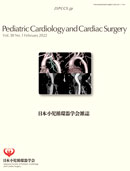Volume 38, Issue 1
Displaying 1-11 of 11 articles from this issue
- |<
- <
- 1
- >
- >|
Preface
-
2022Volume 38Issue 1 Pages 1-2
Published: February 01, 2022
Released on J-STAGE: August 31, 2022
Download PDF (135K)
Review
-
2022Volume 38Issue 1 Pages 3-14
Published: February 01, 2022
Released on J-STAGE: August 31, 2022
Download PDF (2143K) -
2022Volume 38Issue 1 Pages 15-20
Published: February 01, 2022
Released on J-STAGE: August 31, 2022
Download PDF (1944K)
Original
-
2022Volume 38Issue 1 Pages 21-28
Published: February 01, 2022
Released on J-STAGE: August 31, 2022
Download PDF (3981K) -
2022Volume 38Issue 1 Pages 29-37
Published: February 01, 2022
Released on J-STAGE: August 31, 2022
Download PDF (325K)
Case Report
-
2022Volume 38Issue 1 Pages 38-47
Published: February 01, 2022
Released on J-STAGE: August 31, 2022
Download PDF (6308K) -
2022Volume 38Issue 1 Pages 48-53
Published: February 01, 2022
Released on J-STAGE: August 31, 2022
Download PDF (1951K) -
2022Volume 38Issue 1 Pages 54-60
Published: February 01, 2022
Released on J-STAGE: August 31, 2022
Download PDF (6381K) -
2022Volume 38Issue 1 Pages 63-69
Published: February 01, 2022
Released on J-STAGE: August 31, 2022
Download PDF (3923K)
Editorial Comment
-
2022Volume 38Issue 1 Pages 61-62
Published: February 01, 2022
Released on J-STAGE: August 31, 2022
Download PDF (122K) -
2022Volume 38Issue 1 Pages 70-71
Published: February 01, 2022
Released on J-STAGE: August 31, 2022
Download PDF (114K)
- |<
- <
- 1
- >
- >|
